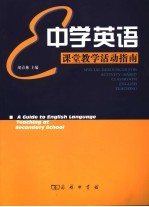图书介绍
中学英语课堂教学活动指南2025|PDF|Epub|mobi|kindle电子书版本百度云盘下载

- 胡春林主编;周文兰,焦晓骏,陆绍寅,宗凤昌编 著
- 出版社: 北京:商务印书馆
- ISBN:7100049156
- 出版时间:2006
- 标注页数:160页
- 文件大小:8MB
- 文件页数:172页
- 主题词:英语课-课堂教学-中学-教学参考资料
PDF下载
下载说明
中学英语课堂教学活动指南PDF格式电子书版下载
下载的文件为RAR压缩包。需要使用解压软件进行解压得到PDF格式图书。建议使用BT下载工具Free Download Manager进行下载,简称FDM(免费,没有广告,支持多平台)。本站资源全部打包为BT种子。所以需要使用专业的BT下载软件进行下载。如BitComet qBittorrent uTorrent等BT下载工具。迅雷目前由于本站不是热门资源。不推荐使用!后期资源热门了。安装了迅雷也可以迅雷进行下载!
(文件页数 要大于 标注页数,上中下等多册电子书除外)
注意:本站所有压缩包均有解压码: 点击下载压缩包解压工具
图书目录
Part One English Teaching Planning2
Ⅰ.What is a lesson plan?2
Ⅱ.What should go into an English language lesson?2
Ⅲ.Why is planning important?3
Ⅳ.How should we plan a lesson?3
Ⅴ.Micro-teaching lesson6
Ⅵ.Tips for classroom teachers7
Ⅶ.Sample lesson plan9
Part Two Activity-based Teaching Methods15
Section 1 Guidance to Listening and Speaking15
Ⅰ.Listening development15
(Ⅰ)Students'problems in listening15
(Ⅱ)Suggestions for the development of listening16
Ⅱ.Speaking development19
(Ⅰ)Students'problems in speaking19
(Ⅱ)Ways to deal with the problems19
(Ⅲ)Suggestions for the development of speaking22
Ⅲ.Sample lesson plan23
Ⅳ.Suggested listening and speaking activities27
(Ⅰ)Cuisenaire rods27
(Ⅱ)Circle games28
(Ⅲ)Picture consequences33
(Ⅳ)Word guessing games34
(Ⅴ)Role play37
(Ⅵ)True/False stories41
(Ⅶ)Picture talking or description42
(Ⅷ)"For or Against"debates45
Ⅴ.Other effective speaking and talking activities45
(Ⅰ)Bribery45
(Ⅱ)Hangman46
(Ⅲ)Time out46
(Ⅳ)The untrophy46
(Ⅴ)The last word47
(Ⅵ)Doctors and patients47
(Ⅶ)Jigsaw puzzle challenge47
(Ⅷ)Something in common or"give me five"48
(Ⅸ)Create a biography48
(Ⅹ)Top five lists49
(Ⅺ)Mini-talks50
(Ⅻ)Erase the dialogue50
(ⅩⅢ)Motivating speaking activities51
(ⅩⅣ)Chain story telling activity52
(ⅩⅤ)Improving discussion lessons53
Section 2 Guidance to Reading54
Ⅰ.Guided reading54
Ⅱ.Reading comprehension57
(Ⅰ)The purpose of reading57
(Ⅱ)How to improve reading comprehension?58
(Ⅲ)Reading approaches59
(Ⅳ)Sample lesson plans67
Ⅲ.Suggested reading activities78
(Ⅰ)Newspaper reading activities78
(Ⅱ)Text quickies81
(Ⅲ) Reading aloud82
(Ⅳ)The spending maze83
(Ⅴ)Jigsaw reading84
(Ⅵ)Working with classroom readers85
(Ⅶ)Activities to do with texts86
Section 3 Guidance to Writing87
Ⅰ.Provide many opportunities for students to write daily87
Ⅱ.An idealised procedure for teaching writing88
Ⅲ.Give students guidance and explicit instruction that develop effective writing skills and strategies90
(Ⅰ)Model writing process90
(Ⅱ)Guide writing strategies91
Ⅳ.Suggested writing activities104
(Ⅰ)Block buster104
(Ⅱ)Dangerous road105
(Ⅲ)Writing an essay on cause and effect107
(Ⅳ)Lexical threads109
(Ⅴ)Role-play writing110
Ⅴ.Other effective writing activities113
(Ⅰ)Story starters113
(Ⅱ)Collaborative/Co-authored writing113
(Ⅲ)Writing/Writers'circles113
(Ⅳ)Writer's notebook113
(Ⅴ)Interactive writing114
(Ⅵ)Writing workshops114
(Ⅶ)Writing through"reverse reading"115
(Ⅷ)Postcards116
(Ⅸ)Writing conferences117
(Ⅹ)Sentence frames118
(Ⅺ)Improving paragraph writing118
(Ⅻ)Songs and storytelling119
(ⅩⅢ)Freeze the writing119
(ⅩⅣ)Organise argument essays120
(ⅩⅤ)Writing organizers and maps121
(ⅩⅥ)Note writing122
(ⅩⅦ)A dark and stormy night—A creative writing activity123
(ⅩⅧ)Inquiry and research writing124
Part Three Related Teaching Methodologies127
Ⅰ.Task-based Language Teaching(TBLT)127
(Ⅰ)What is a task?129
(Ⅱ)What are the reasons for TBLT?130
(Ⅲ)What are the differences between TBLT and the traditional teaching method?131
(Ⅳ)How do teachers design tasks?132
(Ⅴ)What are the stages of TBLT?133
(Ⅵ)How do teachers plan tasks for a lesson?135
(Ⅶ)What are the misconceptions in TBLT?135
(Ⅷ)Sample lesson plan136
Ⅱ.Student-centred Learning(SCL)138
(Ⅰ)The definition of student-centred learning138
(Ⅱ)The features of student-centred learning139
(Ⅲ)Teacher skills needed in student-centred approaches140
(Ⅳ)The shift from teacher-centred to student-centred learning141
(Ⅴ)Creative student-ccntred materials143
(Ⅵ)Sample lesson plan144
Ⅲ.Action Research(AR)Overview148
(Ⅰ)What is Action Research?148
(Ⅱ)Why should teachers do Action Research?148
(Ⅲ)What are the steps in the Action Research process?149
(Ⅳ)Where can your research question(s)come from?149
(Ⅴ)What evidence can you collect to see whether your solution has worked?150
(Ⅵ)Guidelines for planning action research projects151
(Ⅶ)Sample teaching plan154
Ⅳ.The Reflective Approach(RA)155
(Ⅰ)Why is RA important?155
(Ⅱ)What is the beginning of the process of reflection?156
(Ⅲ)What to do next?157
(Ⅳ)How to become a reflective teacher?158
(Ⅴ)Sample teaching plan158
(Ⅵ)How is RA different from AR?160
热门推荐
- 1935985.html
- 603956.html
- 1376833.html
- 3573712.html
- 642843.html
- 1165226.html
- 339070.html
- 3626498.html
- 1304022.html
- 1339595.html
- http://www.ickdjs.cc/book_574798.html
- http://www.ickdjs.cc/book_1067506.html
- http://www.ickdjs.cc/book_1635308.html
- http://www.ickdjs.cc/book_2402678.html
- http://www.ickdjs.cc/book_2906819.html
- http://www.ickdjs.cc/book_928382.html
- http://www.ickdjs.cc/book_3588526.html
- http://www.ickdjs.cc/book_1921319.html
- http://www.ickdjs.cc/book_520290.html
- http://www.ickdjs.cc/book_326608.html